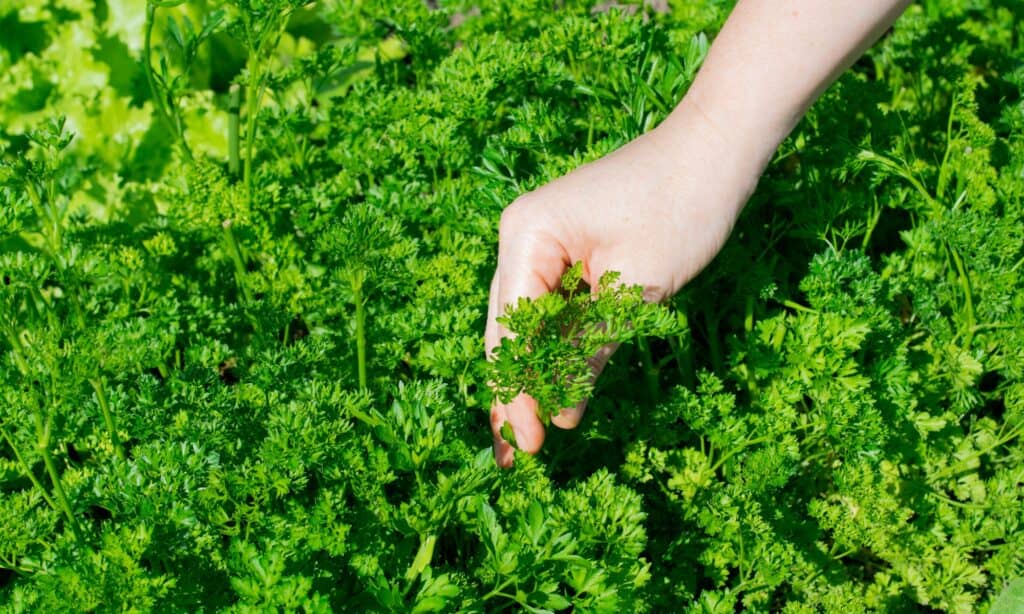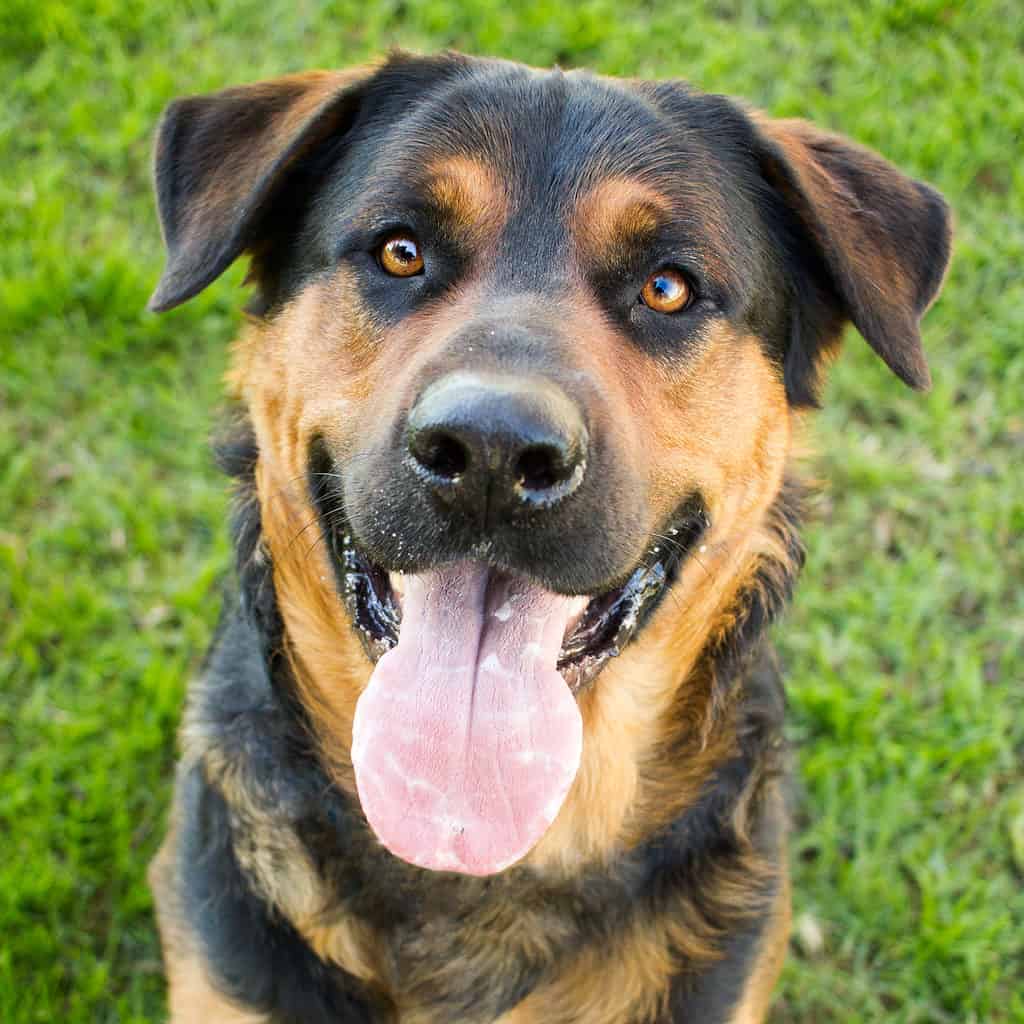Can dogs eat parsley? While parsley is often referred to as a “superfood,” the definition of a superfood is thrown around a lot these days. You can find people calling just about any food a superfood, so seeing the word attached to a specific food on the internet doesn’t mean much.
A superfood contains many vitamins and minerals and is considered nutritionally dense. Parsley does contain a lot of nutrients while being low in calories. It is commonly considered a superfood.
Luckily, curly parsley is safe for dogs to eat in moderation. Other parsley types are unsafe, as they can be potentially toxic. Furthermore, we don’t recommend feeding your dog much parsley – even of the curly variety. Too much parsley can cause health issues, particularly gastrointestinal issues.
If you begin giving your dog parsley, we recommend starting slow. If your dog isn’t used to parsley, it can cause substantial digestive problems.
Potential Benefits of Parsley

Parsley has both curly and flat-leaf varieties.
©iStock.com/Oksana Chaun
There are a few reasons you may want to give your dog curled Parsley. Remember, only curly parsley is safe for dogs.
Breath and Dental Health
Parsley is best known for its breath control. Simply put, It helps your dog’s breath smell better. You only have to feed your dog a few nibbles of parsley for this to work. Furthermore, parsley oil can be added to your dog’s water, which can help with continuous breath control.
However, bad breath is often connected to dental issues. Therefore, it is essential not to use parsley to cover up more profound problems.
Nutritional Density
Surprisingly, parsley is pretty dense in nutrients. It contains all sorts of vitamins, such as vitamins A, C, and K. It even includes harder-to-find nutrients like folic acid and antioxidants. Therefore, this plant is a good option for those looking to add extra nutrients to their dog’s diet.
However, your dog would have to eat quite a bit to gain these nutrients, which we don’t recommend as this can cause gastrointestinal issues. Due to this, we can’t conclude that minor amounts of curled parsley in your dog’s diet may lead to increased nutrition.
Increased Immunity
The scientific literature hasn’t yet confirmed these findings, but parsley could have some immunity-boosting benefits and antimicrobial and anti-inflammatory properties.
As parsley might cause digestive issues, we suggest using other immune-boosting supplements.
Potential Downsides of Parsley
Curly parsley is the only type of parsley that is suitable for dogs. Others are toxic and can cause a range of issues. However, curly parsley isn’t completely safe, either.
Upset Stomach
All types of parsley can cause gastrointestinal issues. Most dogs aren’t used to consuming parsley. Therefore, you should only give your dog a very small amount. Luckily, digestive issues usually dissipate within a day and don’t need vet treatment.
Still, some dogs are more prone to complications due to digestive issues than others. Dogs with underlying digestive issues may experience a worsening of symptoms.
Blindness
Some types of parsley contain very high amounts of furanocoumarins. This toxin can cause blindness in dogs, as well as dermatitis. Therefore, you shouldn’t feed your dog any other type of parsley but curly. Spring, flat-leaf, and Italian parsley are all toxic.
Pregnancy Complications

Never give parsley to pregnant dogs, as it can trigger contractions.
©Pavel Shlykov/Shutterstock.com
You shouldn’t give parsley to pregnant dogs, as it can cause contractions. It does take quite a bit of parsley for this to occur. However, smaller dogs are more susceptible to parsley due to their size.
Contractions can cause premature birth. This causes severe problems for the mother and puppies. Giving birth even a few days early can spell serious problems for puppies.
Kidney Issues
You shouldn’t feed your dog large amounts of parsley as it can cause kidney issues. Most of the time, this occurs after long-term consumption. However, it can also occur if your dog eats a bunch of parsley at once.
The kidney-harming effects largely occur due to the plant’s high fiber content and diuretic effects. If your dog has existing health problems, you may see a worsening of symptoms.
How Much Parsley Can I Give To My Dog?

If you give your dog a commercial parsley product, always follow the directions on the container.
©Mokuahi/Shutterstock.com
You can only give your dog a few sprigs of curly parsley at a time. If it is their first time eating parsley, you should give even less than that. Parsley can cause stomach upset if your dog isn’t used to eating it, just like most new foods. Therefore, you’re better off slowly introducing your dog to the food.
With that said, many treats and chews contain parsley. These are typically dosed for dogs, so you don’t have to worry about your dog consuming too much parsley. However, all dog treats can cause stomach upset if eaten in excess. Therefore, you should still moderate how much parsley your dog consumes.
If you’re giving your dog a commercial parsley product, like parsley oil, we recommend following the directions on the container. While parsley doesn’t usually cause overdoses, it absolutely can if you give your dog too much. Therefore, always follow the directions and track how much your dog consumes.
Can I Give My Dog Fresh Parsley?
Yes, you can give your dog fresh curly parsley. It does not need to be cooked. The important thing is that you feed your dog a moderate amount of curly parsley.
Many people give their dogs fresh parsley instead of cooking it. Not only is the prep easier this way, but it also limits the oil content. If you cook the parsley, you’ll likely have to add other ingredients (like oil). Therefore, fresh raw parsley is often the best option.
Alternatively, you can mix the parsley with their food or give them treats with parsley as a main ingredient.
How Do I Add Parsley to My Dog’s Food?
If you add parsley to your dog’s food, the easiest method is to shred a small amount into fine pieces. Then, when your dog eats their food, it will also consume the parsley.
We recommend shredding the pieces very finely, as many dogs will eat around the parsley if it is left in larger chunks.
Some dogs are very picky and won’t touch their food if parsley is in it. Luckily, parsley treats are available and often tastier than fresh parsley. These treats are a solid option for dogs that won’t consume raw parsley.
Wet food often works as a better base, as it helps cover up the parsley. Furthermore, it is much harder for dogs to eat around parsley when the herb is mixed into wet food.
Conclusion
To conclude, curly parsley can be healthy for dogs. The other varieties are high in toxins that can cause blindness in some worst-case circumstances. While opting for the curly parsley, remember that it should be fed in small amounts. High amounts can lead to an upset stomach and other gastrointestinal discomforts.
Some dogs are more sensitive to parsley than others. Therefore, we highly recommend starting with a small amount and building up to a bigger amount (if necessary).
Fresh parsley is the best option in most cases. However, there are tons of different treats and oils available.
Up Next
The photo featured at the top of this post is © Pixel-Shot/Shutterstock.com
Ready to discover the top 10 cutest dog breeds in the entire world?
How about the fastest dogs, the largest dogs and those that are -- quite frankly -- just the kindest dogs on the planet? Each day, AZ Animals sends out lists just like this to our thousands of email subscribers. And the best part? It's FREE. Join today by entering your email below.
Thank you for reading! Have some feedback for us? Contact the AZ Animals editorial team.






